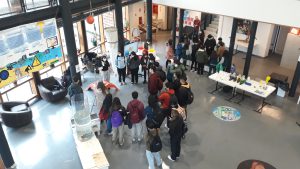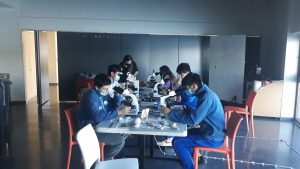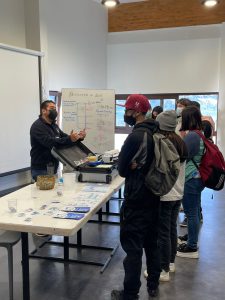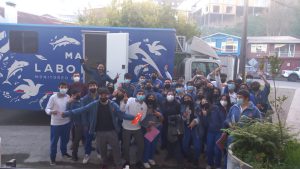The interactive scientific exhibition MACH-IFOP, arose through a contact made by the research and development center in natural resources LACUY Ltda., with whom MACH has a collaboration agreement to carry out scientific dissemination in the commune of Castro and the Chiloe Island. LACUY, in this way, made arrangements with the Creation Center (CECREA) in Castro, dependent on the Ministry of Culture, Arts and Heritage, to have the first coordination meetings to start managing the realization of an interactive exhibition, with a focus on Harmful Algal Blooms (HABs), How? These processes are studied in IFOP through its Harmful Algae Study Center (CREAN), and which one? It is the approach that the MACH project is taking to study HABs. The activity was conceived as an exhibition during the week of May 16 to 20, with different spaces in the facilities of the CECREA center, where students from the district of Castro and other communities of the Big Island of Chiloe could go through stands of physical and biological oceanography. For the first part, researchers from the Department of the Environment – IFOP (Putemún headquarters, Castro) were invited to participate, who set up an exhibition with oceanographic equipment for taking samples, as well as explaining fundamental concepts of physical oceanography (salinity, currents, pH, among others). For the biological oceanography section, the exhibition was in charge of the CREAN center and the MACH project, where concepts such as plankton in the ocean, the diversity of phytoplankton, the main harmful microalgae, and the technologies we use to study these processes were presented. The exhibition was completed by the mobile laboratory of the MACH project, belonging to the Universidad de la Frontera (UFRO), as a support to show students and the general public the type of equipment used for taking and processing samples in the ocean and how HAB-producing microalgae are detected.
The exhibition was focused on groups of schoolchildren from primary to secondary education in the mornings. It was open to the general public in the afternoons, where we also received groups of schoolchildren from technical schools, with a focus on the area of aquaculture, who participated in a tour adapted to their requirements. They were also invited to a scientific talk on Wednesday 18, presented by Dr. Gonzalo Gajardo (Los Lagos University), senior researcher of the MACH project, who accompanied us for two days at the exhibition, addressing one of the research topics of the project; the interaction between harmful microalgae and bacteria in the ocean.
In summary, the exhibition presented eight stands with diverse activities to explain the complexity of the processes of Harmful Algal Blooms and the different strategies for their study. We had the presence of 12 scientists who worked as monitors during the exhibition, where more than 400 young people from Casto, Dalcahue, Chonchi, Ancud, and Curaco de Vélez visited us during the week.

Exhibition in the entrance hall of the CECREA center (Physical Oceanography).

Exhibition on the second level of the center (Biological Oceanography).

Exhibition on the second level of the center (Biological Oceanography), where the laboratory suitcase was presented as a tool for field monitoring.

Mobile laboratory, installed on the outskirts of the CECREA center, as a complement to the Interactive Scientific Exhibition.